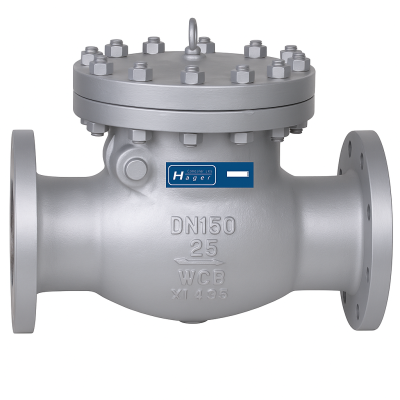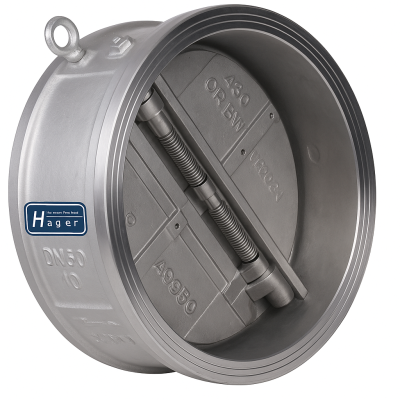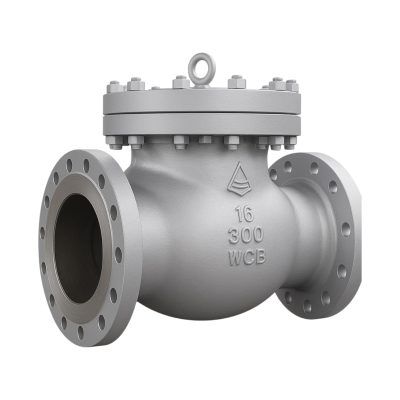Check Valves nach ANSI
Swing Check Valve sorgt dafür, dass das Fluid im Rohr nur in eine Richtung fließen kann. Durch den Druck des Fluides auf die Rückschlagklappe, drückt sie diese in den Sitz und verhindert somit den Rückfluss. Hier kann aber auch zusätzlich ein Hebel mit Gewicht angebracht werden.
Die wichtigsten Eigenschaften von Check Valves
Check Valves sind selbsttätig arbeitende Rückschlagarmaturen, die den Durchfluss nur in eine Richtung zulassen und so zuverlässig Rückfluss verhindern – ohne externe Steuerung. Sie sind in verschiedenen Bauarten wie Swing-, Piston- oder Dual-Plate-Typen erhältlich, für horizontale oder vertikale Einbaulagen geeignet und decken Nennweiten bis DN 900 ab.
Rückflussverhinderung durch automatische Selbstschließung
Alle Ventiltypen schließen automatisch bei nachlassendem Druck oder Rückfluss – ganz ohne externe Steuerung. So wird der Rückfluss zuverlässig verhindert.
Optimierter Durchfluss beim Swing Type
Die ungeführte Scheibe der Swing Check Valve ermöglicht einen vollen, ungehinderten Strömungsdurchlass und minimiert Druckverluste – ideal für Anwendungen mit hohem Volumenstrom.
Präzise Steuerung bei Hochdruck mit Piston Type
Die geführte Kolben- oder Kugelscheibe des Piston Type Ventils sorgt für exakten Sitz und zuverlässige Funktion bei hohen Drücken und Strömungsgeschwindigkeiten – besonders robust und langlebig.
Häger Check Valve nach ANSI Norm (Check Valve Swing Type)
Datenblätter
Größe: 2“ bis 30“
LBS: 150, 300, 600, 900, 1500, 2500
Gehäuse: 1.0619, A216 WCB, 1.4408, 1.4306, 1.4404, 1.1138, 1.4308, 1.5419, 1.7357, 1.7379, CF8M, CF3M, CF3, WC1 WC6, WC9, LCB, LCC
Beschreibung zu unseren Check Valves:
Baulänge nach ASME B16.10. Diese Industriearmatur arbeitet völlig autark und wird durch den Fluidstrom geöffnet. Armaturen mit Konformitätserklärung und CE-Kennzeichnung nach DGRL97/23/EG. Der Anschluss ist in Flanschausführung (RF) ASME B16.5 und Schweißenden ASME B16.25 wählbar. Verschraubter Deckel.

- Klappenscheibe in verschiedenen Werkstoffen erhältlich
- Je nach Werkstoffwahl sind die Rückschlagklappen für Wasser, Dampf, Öl, GAS oder sonstige aggressive Medien geeignet.
- Sonderlackierung gemäß Kundenanforderung
- Betriebs.-u. Wartungsanleitungen der Absperrschieber können in verschiedenen Landessprachen zur Verfügung gestellt werden.
- EAC TR –TS Konformitätsdeklarationen der Zollunion auftragsunabhängig für den Export und Einsatz der Produkte in der Russischen Föderation, Weißrussland oder Kasachstan (EAC), Gültigkeit 1, 3 oder 5 Jahre. EAC GOST TR TS 010/2011 (Machinery directive) oder EAC GOST TR TS 032/2013 für Armaturen größer und inkl. DN25
- Armaturenpass TP nach GOST 2.601 – 2006
- TÜV Abnahmen (3.2)
Häger Check Valve nach ANSI Norm Check Valve Spring Loaded
Datenblätter
Größe: 1/2“ bis 12“
LBS: 150, 300, 600, 900
Gehäuse: 1.0619, A216 WCB, 1.4408, 1.4306, 1.4404, 1.1138, 1.4308, 1.5419, 1.7357, 1.7379, CF8M, CF3M, CF3, WC1 WC6, WC9, LCB, LCC
Beschreibung zu unseren Check Valves:
Baulänge nach ASME B16.10. Diese Industriearmatur arbeitet völlig autark und wird durch den Fluidstrom geöffnet. Armaturen mit Konformitätserklärung und CE-Kennzeichnung nach DGRL97/23/EG. Der Anschluss ist in Flanschausführung (RF) ASME B16.5 und Schweißenden ASME B16.25 wählbar. Verschraubter Deckel.

- Disc (Kegel) in verschiedenen Werkstoffen erhältlich
- Spring (Feder) auch in INCONEL oder ähnlich verfügbar
- Je nach Werkstoffwahl sind die Rückschlagventile für Wasser, Dampf, Öl, GAS oder sonstige aggressive Medien geeignet.
- EAC TR –TS Konformitätsdeklarationen der Zollunion auftragsunabhängig für den Export und Einsatz der Produkte in der Russischen Föderation, Weißrussland oder Kasachstan (EAC), Gültigkeit 1, 3 oder 5 Jahre. EAC GOST TR TS 010/2011 (Machinery directive) oder EAC GOST TR TS 032/2013 für Armaturen größer und inkl. DN25
- Armaturenpass TP nach GOST 2.601 – 2006
- TÜV Abnahmen (3.2)
Häger Check Valve Dual Plate (Wafer Type) - Doppelflügel Rückschlagklappe
Datenblätter
Größe: 2“ bis 24“
LBS: 150, 300, 600, 900
Gehäuse: 1.0619, A216 WCB, 1.4408, 1.4306, 1.4404, 1.1138, 1.4308, 1.5419, 1.7357, 1.7379, CF8M, CF3M, CF3, WC1, WC6, WC9, LCB, LCC
Beschreibung zu unseren Check Valves:
Baulänge nach ASME B16.10. Diese Industriearmatur arbeitet völlig autark, bedarf keiner Betätigung und wird durch den Fluidstrom geöffnet. Armaturen mit Konformitätserklärung und CE-Kennzeichnung nach DGRL97/23/EG. Der Anschluss ist in Flanschausführung (RF) ASME B16.5 und Schweißenden ASME B16.25 wählbar. Verschraubter Deckel.

- Klappe bzw. Flügel verschiedenen Werkstoffen erhältlich
- Spring (Feder) auch in INCONEL oder ähnlich verfügbar
- Je nach Werkstoffwahl sind die Dual Plate Check Valves für Wasser, Dampf, Öl, GAS oder sonstige aggressive Medien geeignet.
- EAC TR –TS Konformitätsdeklarationen der Zollunion auftragsunabhängig für den Export und Einsatz der Produkte in der Russischen Föderation, Weißrussland oder Kasachstan (EAC), Gültigkeit 1, 3 oder 5 Jahre. EAC GOST TR TS 010/2011 (Machinery directive) oder EAC GOST TR TS 032/2013 für Armaturen größer und inkl. DN25
- Armaturenpass TP nach GOST 2.601 – 2006

Industrie – Check Valves (Spring Loaded)
Die Spring Loaded Check Valve ist ein Ventil, dass sich bei Reduzierung eines bestimmten Drucks von selbst schließt und sich mithilfe einer Feder (Spring) durch den Druck automatisch öffnet. Sie arbeitet somit autark.
Die Spring Loaded Check Valve kann horizontal oder vertikal installiert werden und optional mit einem Regelkegel zur präziseren Durchflussregulierung ausgestattet werden. Sie ist in Nennweiten von ½” bis 12″ mit Flansch- oder Schweißenden nach ASME-Standard erhältlich und auf Wunsch auch in Inconel-Werkstoffen sowie mit Schwerlasthaken für größere Größen lieferbar.
- Langjährige Erfahrung im Projektgeschäft
- Persönliche Beratung und individuelle Lösungen
- Hohe Qualitätsstandards und Zuverlässigkeit
- Breites Produktportfolio für verschiedene Anwendungen
Industrie – Check Valves (Dual Plate)
Um den Rückfluss des Fluids in den Rohren zu verhindern, wird eine Klappe zwischen zwei Flanschen im Rohr angebracht und es kann dadurch nur in eine Richtung fließen. Diese Dual Plate Check Valve muss nicht betätigt oder eingestellt werden, da sie ganz eigenständig arbeitet.
Vorteilhaft ist hier auch der gering benötigte Öffnungsdruck der Valve. Sie wird mit einer Feder (Spring) ganz leicht geöffnet, die auch in Inconel Werkstoffen eingebaut werden kann. Bei Reduzierung des Drucks, schließt sich das Ventil automatisch. Wichtig ist, dass die Dual Plate Check Valve waagerecht in eine Rohrleitung eingebaut wird. Die Armatur ist mit einem Pfeil versehen, der die korrekte Durchflussrichtung anzeigt.





